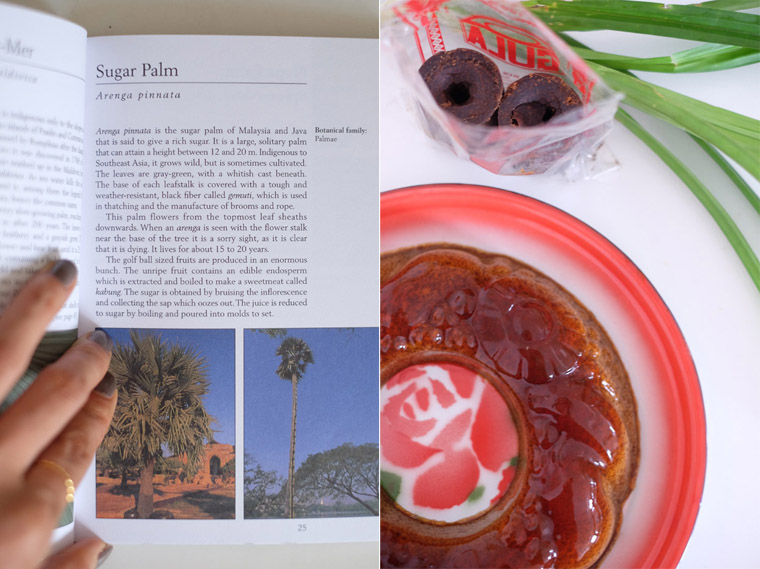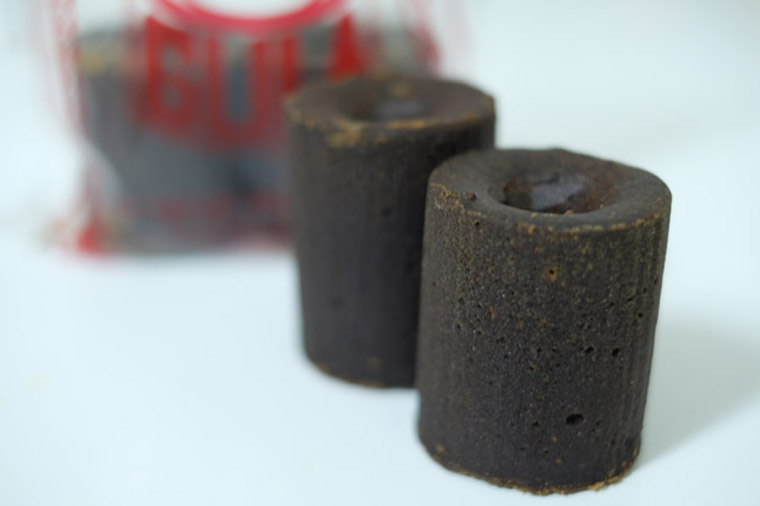Palm sugar is made from the sap of palm trees trunks. In Malaysia, it is probably made from sugar palm (arenga pinnata). The sucrose-rich sap is boiled down to produce a thick brown syrup, poured into a bamboo mould and then hardened into round cylinder blocks. That explains why gula melaka comes in blocks.
Taste & smell
100% Pure gula melaka has a smoky flavour and smell, which is significantly different from regular sugar. When I first use it, I thought I accidentally burned it! Gula Melaka smells very fragrant unlike regular sugar which is without scent.
Other names
Palm sugar and coconut sugar are different. According to wikipedia:
“Coconut sugar is a sugar produced from the sap of cut flower buds of the coconut palm. In some areas, predominantly in Thailand, the terms “coconut sugar” and “palm sugar” are often used interchangeably. However, coconut sugar is different both in taste, texture and manufacture methods from palm sugar, which is made from the sap in the stems of the Palmyra palm, the date palm, the sugar date palm, the sago palm or the sugar palm.”
- English name: Palm sugar
- Malay name: Gula Melaka
- Chinese name: Ye tong (椰糖)
Where to buy
They are easily available at local supermarkets. However, good quality ones are normally available at traditional wet market and small sundry shops – especially in towns like Melaka in Malaysia.

How to choose good quality gula melaka
Pure gula melaka is made the sap of palm only. However, many manufacturers add sugar so they can produce larger quantities and sell at a lower price. While I like most of my food unadulterated, I personally feel that gula melaka with added sugar is not necessarily a bad thing.
Pure gula melaka can be expensive and the smoky flavour is an acquired taste. Those with mixed sugar allows more people to have a taste of this delicious sugar without having to fork out too much. Having said that, I still like my gula melaka pure. Here’s how to choose good quality ones:
- Blocks – If it’s sold in blocks, chances are that they are made traditionally.
- Dark in colour – Pure gula melaka has a deep brown colour. Lighter ones are heavily adulterated with white sugar.
- Soft and crumbly – Pure gula melaka is rather soft and crumbly. Whereas the rock hard ones shows that is has added sugar. When buying gula melaka, press the sugar with your finger nail. Good one should be dent. It should be easily shaved into your food too.
- Smell – If you are torn between two brands, do a sniff test. The better ones with higher palm sugar content tend to smell much more fragrant.
How to use
In countries like Malaysia and Thailand, gula melaka is used as sweetener in dessert. Instead of white processed sugar, you can use this.
- Make it into sugar syrup – Cook gula melaka with water and add pandan leaves for fragrance.
- Substitute for sugar – Shave it and use it to flavour coffee or in your cooking
Storage
Store in a cool and dry place. Good gula melaka melts easily and may turn into a sticky paste if not stored somewhere cool. If stored properly, it should last for years.


Pingback: Yoghurt With Nangka & Gula Melaka – New Malaysian Kitchen
Can you tell me how heavy is a block of gula?
Sometimes the gula is already melted down and sold in bottles
Hi Mrs Koh. The one that I use is about 55 g per block. But its a small block. For bigger blocks, an intelligent guess could be about 100 – 150 g perhaps? This is the brand that I am currently using: https://www.newmalaysiankitchen.com/where-to-buy-good-quality-gula-melaka-palm-sugar-in-kuala-lumpur/
Pingback: Where to buy good quality Gula Melaka (palm sugar) in Kuala Lumpur - New Malaysian Kitchen
Pingback: 【調味料シリーズ】グラ・マラッカ_Gula Melaka | サマサマ~sama-sama